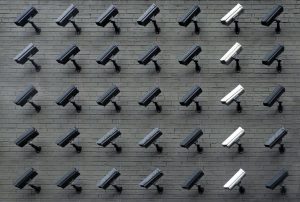Imagine being transported to an elementary school twenty years ago. Before the average student had personal cell phones. The only camera on campus was perched at the front door of the building to monitor who entered and exited. Teachers were able to monitor students’ progress and encourage learning without the assistance of extensive surveillance technology.
Fast-forward to the present, year 2021. Flying cars and other flashy symbols of the Jetson “utopia” seem like distant fantasies, but technology has progressed in other ways. Students with disabilities have access to material that would have been wholly unavailable if not for the creation of learning assistance technology. Virtual learning would have been impossible or extremely burdensome without contemporary technological advancements. Despite the benefits of aspects of modern technology, surveillance of students at all grade levels has raised concerns from privacy experts, educators, and parents.
Impetus for School Surveillance
Due to an upsurge in traumatic events associated with schools that sometimes result in death, administrators have been forced to reimagine security. School shootings are more frequent than ever, occurring every 77 days or so in America in comparison to 122 in 2000. Mental illness amongst youth has also increased; suicide is the second leading cause of death amongst adolescents aged 12-18. It is no surprise that schools have begun investing in any measure they can to prevent these tragedies.
A popular solution is digital monitoring, which school officials typically justify as compliance with the Children’s Internet Protection Act that requires schools to adopt an internet safety policy that addresses the safety and security of minors. Edtech industry leaders, such as Gaggle and GoGuardian, collectively serve thousands of schools across the country, including Chicago Public Schools. When digital surveillance was first introduced, it was primarily limited to monitoring school-owned devices but has since expanded to any student activity associated with school-issued accounts. The scope of school digital surveillance services includes, but are not limited to social media tracking, browser data mining, and keystroke logging. In illustration, a student could send a message on their school-issued account expressing the desire to self-harm and the school would be alerted immediately.
At the collegiate level, schools such as Syracuse University, implemented technology that tracks students’ location via Bluetooth. SpotterEdu, founded by a former college basketball coach, is one of the most prominent software services in the industry; currently operational on over thirty campuses nationwide. Inconspicuous Bluetooth beacons installed in classrooms and other gathering spaces send signals to the school whenever a student comes within proximity of one. If a student is late for class, the program can alert the professor and any other pertinent school staff. Syracuse professor Jeff Rubin hailed the software for its’ impact on student attendance. This new method of holding students accountable for showing up to class has been so successful for Professor Rubin that attendance reached unprecedented highs.
SpotterEdu and similar technologies can also be used to monitor students’ mental health. For instance, a student that never gets near the Bluetooth beacon in the school dining hall could indicate the student has an eating disorder. Another company stated they collect approximately 6,000 location data points per student each day. Some software takes location-tracking one step further and monitors how long a student remains in a space.

Photo by Lianhao Qu on Unsplash
Although the data collected assists schools in managing the success of the student body at large, many schools segregate the data for a more focused analysis on students of color and other demographics that universities may deem as high-risk. However logical it might be to closely monitor students of color in an attempt to boost academic success, the surveillance of people of color has traditionally led to criminalization.
Increased Surveillance Post-Pandemic
For schools where in-person learning is offered, adequate contract tracing and other protocols to quell the potential for a Covid-19 outbreak within a school is detrimental to remaining open. So strong is the desire to remain open that some districts have shelled undisclosed amounts of money on air purifiers with a $900 retail price.
Others have responded to the imminent threat of a schoolwide Covid-19 outbreak by partnering with companies that provide extensive tracking services. One company has the following on their website: “AI-precise tracking and micro-geofencing enables automatic live and historical tracing of individuals with an elevated temperature throughout the entire network with unparalleled accuracy and privacy”.
On the same company’s ‘Reopen Schools Safely” page is a dystopian video introduction to some of the benefits and mechanics of the tracking system. The technology claims it possess the capability though Bluetooth-enabled badges among other equipment to enforce social distancing by geofencing, provide “precise” 3D locations on the campus, and collect and display health data for each student and staff member. As long as the school maintains control over student information and does not share data without the permission of the student’s guardian, they are allowed to utilize these types of services.
In the event of a hostile or unwelcome individual on campus, the system can be used to send warnings to everyone within the school network. After an uptick in school shootings only allayed by a virus-induced pandemic, investing in student safety is understandable. Combatting growing instances of mental health issues through the often praised method of data collection and analysis is also expected amidst a larger society that promotes data as a one-size fits all solution.
Despite the purported benefits, increased surveillance of students is associated with negatively impacting the students’ interpersonal development and fortifies the school-to-prison pipeline. Marginalized students were disciplined at disproportionate rates for decades and the adoption of contemporary technology exacerbates the phenomenon even further. For example, a district in Alabama implemented a social media monitoring system that resulted in 14 expulsions. The student population was only 40% African American yet 12 of the expulsed were Black. Female students and students with disabilities are also more likely to be negatively impacted by the same software that is supposed to protect them. Elizabeth Laird, senior fellow for student privacy at the Center for Democracy and Technology writes:
“Both machine-learning algorithms and human analysts are at risk of misunderstanding what students write – particularly if the human analysts are older, or from different cultural backgrounds than the students they are monitoring, experts said. If digital surveillance companies scanning students’ emails and chats misinterpret their jokes or sarcasm as real threats, that ‘could expose students to law enforcement in a way they have not been in the past’”.
School districts are expending millions of dollars on high-tech surveillance and there are still no independent studies affirming the alleged positive benefits. We must consider alternative ways to strengthen school safety and mitigate the risk of viral outbreaks that have not been proven to overexpose students to law enforcement.
Essence Hill is a student at Loyola University Chicago School of Law and wrote this blog post as part of the Education Law Practicum.

